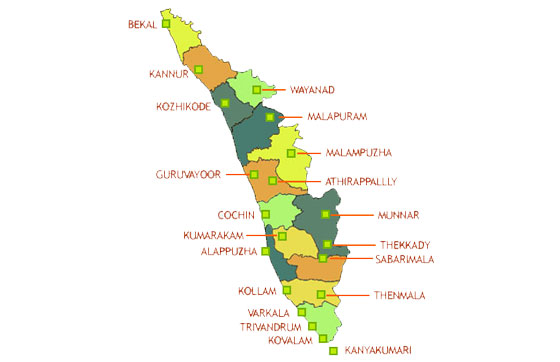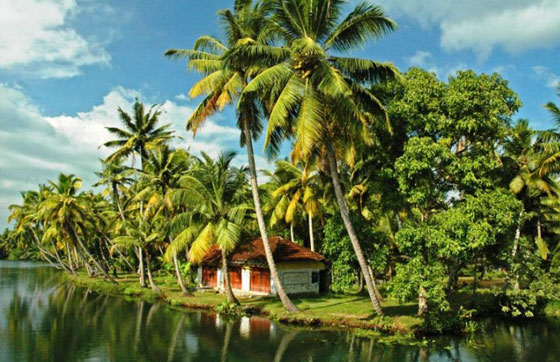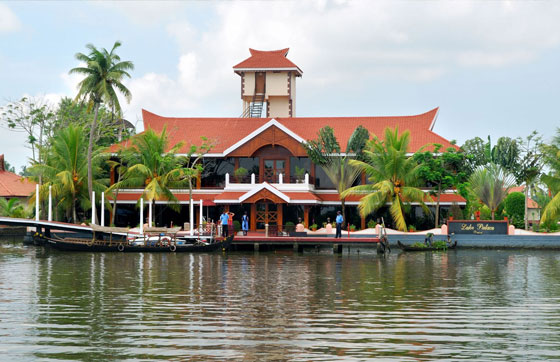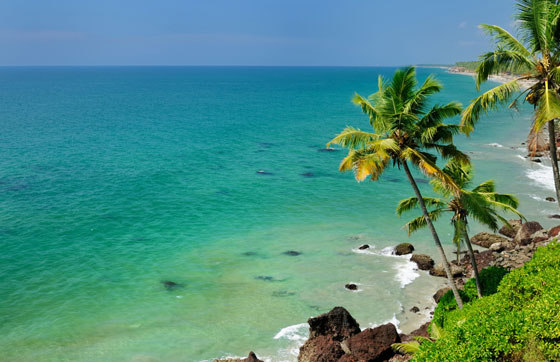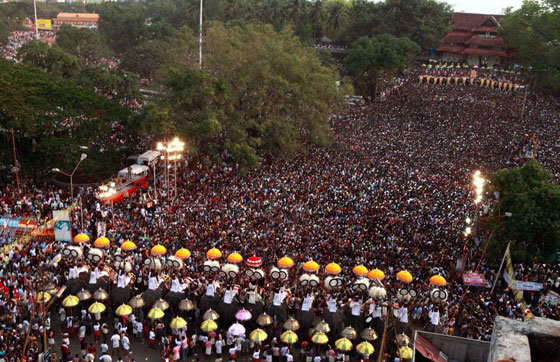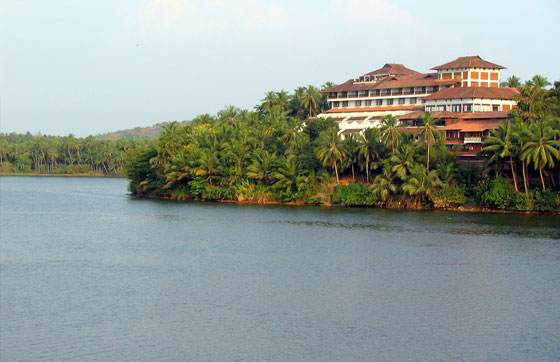Tourist destination in Malappuram
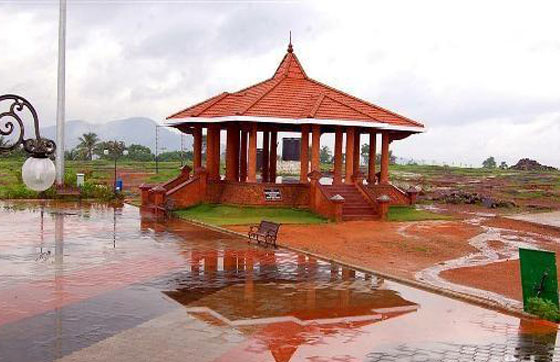 Malappuram
Malappuram
Malappuram is the main tourist destination in Malappuram District is the head quarter, which is 26 kms. South east from Calicut Airport and 28 Kms. northeast from Tirur railway station. It was a military head quarters from olden times The Zamorins of Kozhikode had their sway over this region and they stationed a part of their armed force here. Para Nambi the chieftain of the Zamorin, ruled with head quarters at Kottappady in Malappuram. Malappuram Nercha, celebrated in summer season, is in reminiscence of martyrs who fought the atrocities of the militia. Royal leisure tours offer Kerala honeymoon Packages Malappuram with special inclusions.
The Britishers recognized the Haig Barracks on top of a hill, at the banks of Kadalundi River, to station their army. Main barracks has now been turned into the seat of district administration. Main district offices are functioning here. Malappuram is the headquarters of the Malabar special Police, established in 1921.
Pookottur near Malappuram, has a place in history, where the Mopla warriors fought the British with their traditional weapons and were killed in cold blood, during the Malabar revolt. Panakkad, 6 km from Malappuram in Malappuram – Parappanangadi road, is a significant religious centre for the Muslims of Kerala. 10 km away from Malappuram, between Anakkayam and Mankada, is Poonkudi Mana, famous for the traditional method of treatment of mental disease. Seminars on modern treatment and traditional methods are conducted here. Poonkudi Thalapoli is a Hindu spiritual festival of this obsession.
Nilambur (Forest area)
Nilambur is well known for its teak plantations. The oldest teak plantation of the world, the Conolly’s Plot is just 2 Kms. from Nilambur town. The plot was named in memory of H.V. Conolly, the Malabar District Collector, who was involved in raising the teak plantation in the entire Nilambur vicinity. Sir Chathu Menon, a forest officer under Conolly, took up the hectic task of planting Teak. Chathu Menon was laid to rest in the Teak garden in Conolly’s Plot. The oldest Teak Kannimari in the plot is a rare attraction. This plot of 2.31 Hectares is nearby the Chaliyar River at Aruvakode, where a country boat ferry is set for tourists.
Teak Museum
World’s first Teak Museum and sub centre of Kerala Forest Research Institute are located Four Kms. away from Nilambur on the side of Nilambur-Gudallur road. In the Teak Museum, visitors can have at hand information on all characteristics of teak. The Museum, arranged in a two storied building, displays articles and details of historic, aesthetic and scientific value. Eighteen Kms. away from Nilambur is Nedumkayam where the rain forests prosper. Elephants and deers can be viewed from the wooden rest house built by the Britishers.
An elephant-taming centre is also a further attraction. Half an hour jeep drive through the dense forests from Nedumkayam, leads to Mancherri, the settlement of Chola Naikas, a primitive tribe. Away from Chaliyar River, 27 Km from Nilambur, is Valamthode, a hill top place where a perennial waterfall attracts tourists. This too is a tribal settlement. Road accessibility is through Kozhikode district by Areekode-Mukkam Road. Nilambur city is renowned for Kovilakams where the Rajas resided and ruled the land. The Kovilakams have stunning frescoes and artworks in wood. The forest division offices (Nilambur North & Nilambur south) are operating from here. It is the terminus of Shoranur- Nilambur railway and it is 40Kms. from Malappuram city.
Manjeri
The place is located Twelve Kms. northeast of Malappuram town, Manjeri is the head quarters of Ernad Taluk. It was a live centre of the National Movement. Manjeri Kovilakam was the seat of the ruling families under the Zamourins. The District Hospital and the District Court are at Manjeri. Some district offices like the District Medical Office, PWD Roads Division, Local Works division etc. are also functioning in this municipality. Anakkayam 2 Kms. from Manjeri was a significant center in the 1921 mass upsurge. Anti British rebellions took place from 1790 itself, in and around Manjeri.
Kottakkal (Ayurvedic Center)
Kottakkal is a world-famous centre of Ayurveda. The Arya Vaidya Sala, established by P.S. Warrier the well-known physician and social reformer. People from different parts of the globe come here for treatment. Art and culture also thrive in Kottakkal with the patronage of Arya Vaidya Sala. P.S.V. Natyasanghom has a unique place in Kathakali. A Kathakali school is run by the sanghom. Venkata Theva temple close to Arya Vaidya sala, is renowned for Mural paintings. Kottakkal Pooram festival is a famous attraction. Experts of music, art, culture and literature of the country, take part in the cultural mela organized in association with the pooram.
Experts from abroad also attended the Annual seminar on Ayurveda and other branches of medicine, conducted as a part of founder’s day of Arya Vaidya Sala. A medicinal herbal garden, preserved by the Vaidyasala is a rare treasure. There is an Ayurveda college at Kottakal. The only Ayurveda mental Hospital of the state runs by The Govt. of Kerala is located here.
Kottakkal is 12 kms. West of Malappuram. National Highway-17 passes through Kottakkal. The distance from here to Calicut airport is 13 kms. and to Tirur Railway station is 16 kms. The prominent Kadampuzha Devi Temple is 10 kms. from Kottakkal, where devotees in and out of Kerala, come and pray to get rid of obstructions in life.
Thirunavaya
Thirunavaya is the land of ancient Mamankom, It is 7 kms south of Tirur. Located on the banks of Bharathapuzha, it is a place of historical significance. In ancient times, Mamankam was a grand meeting of the rulers held once in 12 years, in which one of them was selected as the ruler of Kerala. It was a massive trade fair also. The Mamankam festival was celebrated for 28 days with great pomp and pageantry where dealers from outside came in ships and barges to Thirunavaya through Ponnani port. Thus, the economical importance of Mamankam was high and hence the right to conduct and organize it was very important.
At the last part of the rule of Perumals, the right of Mamankam was with Vellattiri, the ruler of Valluvanad. Later the Zamorin of Kozhikode, took this right by power and this resulted in argument and bloodshed between these two Rajas. Valluvanad Raja used to send Chaver warriors to fight until death, to recapture the right from the Zamorin, who would stand poised at Nilapadu thara inThriunavaya, bounded by a huge contingent of soldiers, in every 12th year. The last of such Mamankam, was believed to be held in 1755, when Zamorin had a hair-breath flee from a chaver aged 16.
The Archeological division shelters the Nilapaduthara, now in the premises of Kodakkal Tile Factory. A deep well called Manikkinar, believed to be dumped with bodies. The place hashree temples, dedicated to the Trimurtis, the gods of creation, nourishment and annihilation of life, according to the Hindu faith strewn on the banks of the Bharathapuzha. The renowned vedic Vidyalaya Othanmar Madom of prehistoric times, is on the bank of Bharathapuzha, near the Siva Temple. This madom was a centre of Aryanisation through Sanskrit and Vedic education, as Thirunavaya was believed to be the major centre, where Parasurama brought and settled Brahmins.
The Palace (Mana) of Puranic reputation Azhvanchery Thamprakkal is 2 kms. North of Thirunnavaya. Navamunkuda Temple, which is believed to be constructed by Nava yogis on the right bank of Bharathapuzha, is an imperative Vishnu temple of Kerala. Pitru Tharpanam is a ritual, held here on the day of Amavasi of Karkidaka(July). People in their wet clothes, offer Balikarma after a dip in the river, for the salvation of sins and to appease the manes.
A marital art festival of Kalripayattu, is conducted during summer on the sands of dry Bharathapuzha. The eminent Changampalli Kalari is near Thirunavaya. During the second week of February, a Sarvodaya Mela is conducted in Thirunavaya where the Gandhians of Kerala, use to gather. The Santikudeeram established by the national leader K. Kelappan, is the centre place of this mela.
Tirur
Tirur is one of the vital business centres of Malappuram district. It is 41 Kms. south of Kozhikode, on the Mangalore-Madras railway line. Thunjan Paramba in Trikkandiyur, 3 km away from Tirur railway station, is consecrated for all who speak Malayalam. This is the birthplace of Thunjuath Ramanujan Ezhuthachan of the 16 th century AD, honoured as the Father of Malayalam literature. Important works of Ezhuthachan, Adhyatma Ramayanam and Harinamakeerthanam are widely recited in Kerala homes.
A memorial for the great poet has been built at Thunjan paramba, where weeklong literary mela is organized in the last week of December.Hundreds of people reach Thunjanparamba with their children, to start them into the world of letters on the Vijayadasami day. Children are made to write on the white sands of Thunjanparamba with their fingers. Young poets of Kerala come on that day to offer their first poem. A Nuxvomica tree the leaves of which are not bitter is a surprise at the Thunjan paramba.
Chamravattom Sastha Temple is located south of Tirur, which is built on the banks of Bharathapuzha. Six kms. from Tirur, is Truprangode where the only temple of Kerala, devoted to Garuda, the bird deity, is located. Chandanakavu, the birthplace of the great 16th century Sanskrit poet and grammarian, Melapthur Narayana Bahttathiri, is 10 kms. away from Tirur in Thirunnavaya – Kottakal road. A memorial has been built there for the poet, where small children are brought for their formal beginning into learning, on Vijayadasami day, as in Thunjan paramba.
Tirur -Kottayi road ends at Padinharakara, where the Bharathapuzha and Tirur River meet to drain into the sea. This place area is distinguished for migratory birds, gathering in thousands during February – April. Tirur witnessed the evil Wagon tragedy of the 1921 rebellion. Seventy prisoners sent to Pothannur, filled up in an airtight goods wagon from Tirur railway station, died of asphyxiation. 4 of them were Hindus. The wagons were returned with the dead bodies to Tirur. These bodies were laid to rest in Khabristan of the mosque nearby. Tirur Municipality has built a town hall in reminiscence of the Wagon Tragedy
Perinthalmanna
The place is situated twenty kms, southeast of Malappuram, this town is the head quarters of Perinthalmanna Taluk. Thirumandhamkunnu temple and Tali temple in Angadipuram, 2 kms. from Perinthalmanna, Kozhikode road, is famous for its Muslim educational complex and Yathimkhana. The Mankada kovilakam, 8 km away in Manjeri Road, was the seat of the ruling family, under old Valluvanad Kingdom.
A Chaverthara, preserved near the Thirumandhamkunnu temple, is a memorial for the martyrs of Mamankam. The Chaver fighters used to cover this place before moving to Thirunnavaya. Eight kms, from Perenthalmanna is Keezhattur, the hometown of great poet of Malayalam, Poothananam Namboodiri of 16th century A.D.
The Guruvayur Devaswom preserves the house of the poet as a monument. Pariyapuram church and Malaparamba church are important Christian Centres. A fort of Tippu sultan is at Paloor near Angadipuram. In the Angadipuram Rest house premises, a monument of Francis Hamilton Bunhnan’s finding of later of laterite stone is built by the Geological survey of India.
Kondotty
The growing town of Kondotty near the Calicut airport is famous for the Nercha in the Pazhayangadi Mosque. It is the birthplace of the great Mappila Poet, Moyiain kutty Vaidyar. He popularized Mappilapatt by his poems on non-religious and idealistic themes. A memorial for the poet is proposed to be built in Kondotty.
The past of Kondotty is linked with that of Kondotty Thangals, the Sufi exponents. Tippu of Mysore brought the first Thangal Mohammed Shah, to bring the mappilas to the side of his rule. The Thangal first stayed at Areekode and later settled in Kondotty.
When the British emerged on the scene putting an end to reign of Tippu sultan, the Thangal switched sides with them. Hence, during the 1921 upsurge, the mappila crowd attacked the residence of the Seventh Thangal, Naziruddin Shah. Kondotty Nercha is held at the tomb of the first Thangal. Nediyiruppu is Two Kms. from Kondotty, from where the Zamorin Kingdom was prolonged. In ancient times, Zamorins were known as Nediyiruppu swaroopams.
Tirurangadi
Tirurangadi was a significant centre of the Khilaphat movement, the National movement and the Malabar Rebellion. It was the Tirurangadi incident on 20th August 1921, that set fire to the outbreak of Mappila revolt. Mampuram Kizhakkepalli was the seat of Khilaphet leader, Ali Musliar and a centre of spiritual education.
The Mampuram mosque on the other side of the Kadalundi is a pilgrim centre. At Mampuram Nercha, People from all religions come and offer agarbathi (incence sticks) for the fulfillment of their desires. Tirurangadi, 24 Kms. west of Malappuram, is now the Block headquarters. A new Taluk is proposed to be formed with its head quarters at Tirurangadi.
There is a big Yatimkhana (Muslim Orphanage) and a P.S.M.O. College and Eight Kms. west of Tirurangadi, is Parappanagadi, which is a vital fishing centre. Fisheries Development Project is functioning here. A fish farm also functions at Ullanam, near Parappangagadi.
Kadalundi Nagaram
Kadalundi Nagaram is located in the northwestern border of Malappuram district, where the Kadalundi River flows into the Arabian Sea. It is 10 km north of Parappanangadi. The nearby railway station is at Vallikkunnu. Kadalundi Nagaram is seasonal residence of migratory birds, which flock in on the vast stretch of water during February – April Pooram festival in the Niramkitha Kotta Bhagavati temple near Vallikunnu, lasts for a week, attracting thousands.
Tanur
The coastal city Tanur, was one of the earliest Portuguese settlements. It is said that St. Francis Xavier visited this place in 1546. Situated 8 km from Tirur, it is a significant fishing centre. Mangalore-Madras railway line passes through this town. The Keraladheeswarapuram temple devoted to Lord Vishnu, which is one among the oldest temples of Kerala, which is 3 Km south of Tanur city. Keraladheeswarapuram is also a weaver’s settlement.
Ponnani
Ponnani is the only port in Malappuram district and one of the oldest ones in Kerala. A tidal port at the mouth of Bharathapuzha, Ponnani is an important fishing centre. Ponnani is linked by road from Kuttipuram railway station. National Highway 17 passes through this town, which is divided by the Canolly Canal, adding to its beauty. Ponnani is a town of mosques and Khabaristans. There are nearly 50 mosques in this place.
Malik Ibnu dinar, the first Islamic missionary who came to Kerala, was believed to have visited Ponnani. Sheikh Zainuddin Makhdoom built the Human Ath mosque, the largest mosque in the city, in the 16th century. Zainuddin was the one who wrote the early history of Kerala Muslims. The religions established Makhdom is prominent all over the country. Trikavu in Ponnani was one among the seats of the Zamorin, from where he controlled the trade and commerce. The well-known Trikavu durga temple is located here. The main celebration of the temple is Navarathri festival.
Ten Kms. southeast of Ponnani, is the renowned Mookkuthala Bhavathi Temple, one of the antique Durga temples of Kerala. It is believed that Sankaracharya is connected with the origin of the temple. The Karthika Mahotsav, celebrated in Varischikam attracts thousands of devotees. The Mookuthala stone, believed to be growing from below the idol every day.
Sukapuram temple near Edappal is another important Hindu temple. Biyyam Kayal is a stretch of backwaters near Ponnani town, where a boat race is conducted yearly, during Onam festival. A permanent spectator area is built for the viewers and nearly a dozen country boats, including some rowed by women, participate. A big system is in progress to increase a tourist complex here, with hotel, park and pedal boats.
Perumpadappu
Perumpadappu was the seat of Cochin princes known as Perumpadappu Swarupam. It is now the headquarters of Prumpadappu Block. Puthenpalli mosque and jaram magnetize devotees. Perumpadappu is about 15 kms. distance form Ponnani. Veliyancode near Perumpadappu in the coastal line is a significant Islamic centre from ancient times, the religious leader Umar Quasi (1757-1852) was also a social reformer.He prompted tax denial, a movement against the land tax that was extraordinary increased by the proprietors with government backing. He was arrested by the Kozhikode Collector and imprisoned. Another social reformer was the successor of the Quasi, Sayed Makti and imprisoned. Another social reformer was the successor of the Qusi, Sayed Makti Thangal, who lectured for secular education of Muslims, for progress in life.
Kottapadi
At the floor of the Cantonment Hill is the maiden called Kottappadi (“fort gate”), though today there are only traces of the old fort built by the British to protect Malappuram from the attainment of Malabar by Mysore.

